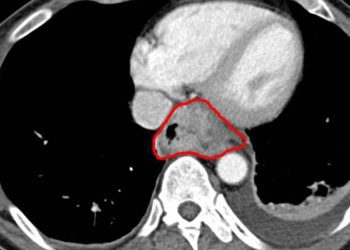2 Minute Medicine Rewind January 31, 2022
1. A molded cast was found to be an acceptable first-line treatment following manipulation of a dorsally displaced fracture of the distal radius when compared with surgical fixation with K-wires
2. In those treated with a cast, careful follow-up was needed as one in eight patients required subsequent surgical intervention as the fracture reduction could not be maintained
Evidence Rating Level: 1 (Excellent)
Fractures of the distal radius are extremely common injuries. However, the optimal management of fractures of the distal radius in adults remains controversial. If bone fragments are undisplaced (i.e., remain in anatomical alignment), accepted practice is to treat fractures of the distal radius non-operatively. However, if bone fragments have displaced, they are “manipulated” to restore normal anatomy. To prevent the bone fragments from falling back out of normal alignment after manipulation, they are supported, which routinely involves surgical implants, such as K-wires, or alternatively, a molded cast. The DRAFFT2 trial aimed to compare wrist function, complications, and quality of life in patients having a manipulation of a dorsally displaced fracture of the distal radius treated with a molded cast without metal implants versus surgical fixation with K-wires plus cast. All patients aged 16 years or over with a dorsally displaced fracture of the distal radius were screened. Patients were potentially eligible if their treating surgeon recommended that they needed manipulation of their fracture. After provision of informed consent and before randomization, baseline data, including pre-fracture and post-fracture wrist function, was recorded. Participants who required a closed reduction of their fracture were allocated to receive either a molded cast (“cast group”) or surgical fixation with K-wires (“K-wire group”). Neither participants nor providers could be blinded to treatment allocation. All patients randomized into the two intervention groups received the same standardized, written physiotherapy advice detailing exercises for rehabilitation. The primary outcome measure was the Patient Rated Wrist Evaluation (PRWE) score at 12 months post-randomization, which quantifies wrist function. Secondary outcome measures included the PRWE score at three and six months post-randomization and health-related quality of life measured by EQ-5D-5L at three, six, and 12 months. A total of 395 participants were included in the primary analysis at 12 months. Participants had a mean age of 60.1 years and were mostly female (417; 83%). No statistically significant difference was seen in the PRWE score at 12 months (cast group (N=200), mean 21.2 (SD 23.1); K-wire group (N=195), mean 20.7 (22.3); adjusted mean difference −0.34 (95% confidence interval −4.33 to 3.66), P=0.87). Additionally, no statistically significant difference was seen at earlier time points. In the cast group, 33 (13%) of participants needed surgical fixation for loss of fracture position in the first six weeks compared with one revision surgery in the K-wire group (odds ratio 0.02, 95% confidence interval 0.001 to 0.10). The authors concluded that surgical fixation with K-wires did not provide better wrist function at 12 months compared with a molded cast, indicating that a cast is an acceptable first-line treatment following manipulation of a dorsally displaced fracture of the distal radius. However, careful follow-up is necessary in patients treated with a cast to evaluate need for subsequent surgical intervention.
1. Low HIV-1 DNA was statistically associated with virological success in a population of sub-Saharan African adults
Evidence Rating Level: 1 (Excellent)
Since antiretroviral treatment (ART) was introduced, HIV-1 morbidity and mortality rates have declined dramatically. Although highly active ART renders the virus undetectable in blood, it cannot be totally eradicated from the body because it persists in infected cells. The size of this viral reservoir may be quantified as the total HIV-1 DNA level in Peripheral Blood Mononuclear Cells (PBMC). Pre-ART HIV-1 DNA load has been found to predict ART success in European severely immunocompromised patients (i.e. higher HIV-1 DNA levels are associated with disease progression). The aim of the Temprano trial was to determine whether HIV-1 DNA levels are associated with virological success in less severely immunocompromised patients who receive early ART in sub-Saharan Africa. Participants aged ≥18 years with HIV infection and a CD4 count ≤800 mm3 were randomized into one of four arms: Arm-1 (Deferred ART), in which ART was deferred until the World Health Organization criteria for starting ART were met; Arm-2 (Deferred ART + isoniazid preventative therapy (IPT)), in which ART was deferred and a 6-month IPT was prescribed; Arm-3 (Immediate-ART), in which ART was started immediately; and Arm-4 (Immediate ART + IPT), in which ART was started immediately and a 6-month IPT was prescribed. All participants were monitored for 30 months and plasma HIV-1 RNA was measured semestrially using a real-time polymerase chain reaction assay. A total of 1013 patients were included. Their medians [IQR] of pre-ART CD4 count, HIV-1 RNA and HIV-1 DNA levels were 465 [379–578]/mm3, 4.7 [4.0–5.3] log10 copies/ml and 2.9 [2.5–3.2] log10 copies/million PBMC, respectively. Pre-ART HIV-1 DNA was significantly correlated with pre-ART HIV-1 RNA (R = 0.59, p < 0.0001). In multivariate analysis, HIV-1 DNA < 3 log10 copies/million PBMC was significantly associated with virological success at M30 after adjustment for other key variables (ART regimen, IPT, sex, age, WHO clinical stage, CD4 and HIV-1 RNA; aOR 1.57; 95% CI 1.08–2.30; p = 0.02). The authors concluded that HIV-1 DNA may be a useful tool for guiding therapeutic decisions in the future.
1. Among individuals who are not yet ready to quit smoking, a 3-week game-based cessation intervention was more effective than solely nicotine replacement therapy (NRT) sampling, in terms of decreasing time to first quit attempt and increasing cessation rates at 6-month follow-up.
Evidence Rating Level: 1 (Excellent)
Currently, interventions for smoking cessation are aimed at individuals who feel ready to quit smoking, although it is estimated that 70% of those who smoke at any time are not motivated to quit. Programs that have been trialled for this population are generally short-term and low-intensity, such as practice quit attempts (which involves brief abstinence through distraction and relaxation), or sampling of nicotine replacement therapy (NRT), both of which are associated with more subsequent successful attempts at cessation. The Take A Break (TAB) randomized controlled trial tested out a novel intervention: They evenly randomized participants that were not ready to stop smoking, with 1 group assigned to an intervention that combined previously successful short-term strategies with a brief abstinence mobile game, and 1 group assigned to NRT sampling only. The measured outcomes were the time to the first quit attempt, and the rate of smoking cessation at 6 months. Specifically, TAB was a 3-week game intervention with a 2-week abstinence challenge, consisting of motivational text messages, daily text self-reports on progress, motivational interviewing and goal setting via telephone call with a trained tobacco treatment coach, mobile games to cope with cravings, and rewards for participating in self-reports (but not rewards for abstinence). All TAB participants received NRT sampling in the form of 72 Nicorette nicotine lozenges, and the TAB intervention encouraged them to be used as a potential cessation aid, but did not mandate it. The TAB group was compared to an NRT sampling control group that did not have access to the game intervention. In total, 53% of those in the TAB group completed all self-report quizzes in the first week, 34% completed all quizzes in the subsequent two weeks, 93% completed the goal-setting call, and 75% used the coping games. The results showed that the time to the first quit attempt was faster in the TAB intervention compared to the control, and with more quit attempts at 6 months (incidence rate ratio 1.67, 95% CI 1.26-2.20, p < 0.001). Furthermore, there was a higher rate of carbon monoxide level-verified cessation in the TAB group compared to the control (18% vs 10%, odds ratio 1.92 95% CI 1.01-3.68, p = 0.048). Overall, this study demonstrated the effectiveness of a game-based intervention integrating motivational interviewing and brief abstinence, compared to NRT sampling, among individuals who were not initially motivated to quit smoking.
1. Around 80% of patients with schizophrenia would be ineligible to participate in randomized controlled trials (RCTs) on relapse prevention with antipsychotics, due to exclusion criteria such as having serious somatic comorbidities, accompanying mood stabilizer or antidepressant usage, substance us history, or suicide risk.
2. Patients with schizophrenia ineligible for these RCTs have higher rates of hospitalization for psychosis and all-cause hospitalization.
Evidence Rating Level: 2 (Good)
Because randomized controlled trials (RCTs) have stringent inclusion and exclusion criteria, to maintain as standardized of a population as possible, the results of RCTs may not always be applicable to the greater affected population. For example, RCTs examining the safety and effectiveness of antipsychotics for patients with schizophrenia often exclude those with substance use disorders, suicidal ideation, and somatic comorbidities, which may result in lack of evidence-based treatments for these individuals. Therefore, the current retrospective study based in Finland and Sweden aimed to quantify the number of individuals living with schizophrenia who would be ineligible for RCTs on the topic of relapse prevention with antipsychotics, as well as determine if these patients have different clinical outcomes compared to eligible patients. This study included patients with a history of hospitalization for schizophrenia, and who completed 12 weeks of outpatient maintenance antipsychotic monotherapy (but not clozapine, which is typically used for treatment resistant patients). A 12-month follow-up began after the completion of these 12 weeks, with the primary outcome being hospitalization for psychosis. Overall, 17,801 patients from Finland and 7,458 patients from Sweden were included in the study. 20.1% of the Finnish cohort and 21.7% of the Swedish cohort would be RCT eligible, whereas 79.9% and 78.3% of the Finnish and Swedish cohorts respectively met 1 or more exclusion criteria. More specifically, 33.0% and 33.7% met 1 exclusion criterion, whereas 18.4% and 17.9% met 3 or more criteria, for the Finnish and Swedish cohorts respectively. The most common exclusion criteria met were serious somatic comorbidities, accompanying mood stabilizer or antidepressant usage, substance use history, and suicide risk. Additionally, patients ineligible for RCTs had higher psychiatric hospitalization rates (hazards ratio 1.34, 95% CI 1.23-1.45 for Finland; HR 1.74, 95% CI 1.52-1.99 for Sweden) and higher all-cause hospitalization rates (HR 1.55, 95% CI 1.43-1.68 for Finland; HR 1.77, 95% CI 1.55-2.03 for Sweden). In conclusion, approximately 80% of patients living with schizophrenia would be ineligible for participation in RCTs on relapse prevention with antipsychotics, and these ineligible patients have higher rates of psychiatric and all-cause hospitalizations.
1. Reductions in HbA1C following initiation and titration of oral antidiabetic medications in Asians were marginally lower compared to results from clinical trials.
Evidence Rating Level: 2 (Good)
Type 2 diabetes mellitus (T2DM) is highly prevalent worldwide, including a specific concentration in Asia, which comprises 60% of the world’s population with this disease. In Asian populations, differences in pathophysiological factors are believed to be associated with increased risk of developing T2DM and accelerated rates of its associated complications. However, the efficacy of existing oral antidiabetic drugs (OAD) medications has not been well studied in real-world Asian populations to date, despite an ongoing upward trend in T2DM prevalence. A retrospective cohort study recruited 57910 adult patients with T2DM in Singapore who were divided into 3 subgroups: patients taking no OADs (n=6606), patients taking OADs without dosage changes during the study period (n=3954), and patients with at least one OAD dosage change during the study period (n=43337). The study comprised a 5-year period and assessed the changes in HbA1C levels following titration of 9 OADs. Results indicated a reduction in HbA1C by 3-12 mmol/mol (0.3 to 1.1%) after OAD initiation, which was slightly lower than reported findings in clinical trials (0.5 to 1.25%). Additionally, the HbA1C lowering effect from uptitration of OADs was 1-8 mmol/mol (0.1 to 0.7%), similar to findings from American real-world studies. While nonadherence could be driving these differences, OAD efficacy may be slightly lower in real-world Asian populations compared to clinical trials.
Image: PD
©2022 2 Minute Medicine, Inc. All rights reserved. No works may be reproduced without expressed written consent from 2 Minute Medicine, Inc. Inquire about licensing here. No article should be construed as medical advice and is not intended as such by the authors or by 2 Minute Medicine, Inc.







